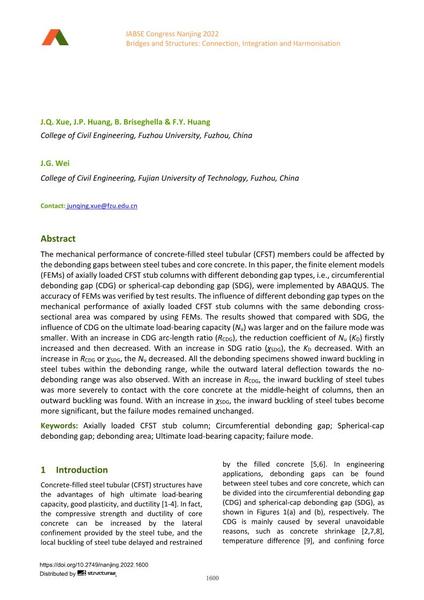Influence of different debonding gap types on mechanical performance of axially loaded CFST stub columns

|
|
|||||||||||
Détails bibliographiques
| Auteur(s): |
J. Q. Xue
(College of Civil Engineering, Fuzhou University, Fuzhou, China)
J. P. Huang (College of Civil Engineering, Fuzhou University, Fuzhou, China) J. G. Wei (College of Civil Engineering, Fujian University of Technology, Fuzhou, China) |
||||
|---|---|---|---|---|---|
| Médium: | papier de conférence | ||||
| Langue(s): | anglais | ||||
| Conférence: | IABSE Congress: Bridges and Structures: Connection, Integration and Harmonisation, Nanjing, People's Republic of China, 21-23 September 2022 | ||||
| Publié dans: | IABSE Congress Nanjing 2022 | ||||
|
|||||
| Page(s): | 1600-1608 | ||||
| Nombre total de pages (du PDF): | 9 | ||||
| DOI: | 10.2749/nanjing.2022.1600 | ||||
| Abstrait: |
The mechanical performance of concrete-filled steel tubular (CFST) members could be affected by the debonding gaps between steel tubes and core concrete. In this paper, the finite element models (FEMs) of axially loaded CFST stub columns with different debonding gap types, i.e., circumferential debonding gap (CDG) or spherical-cap debonding gap (SDG), were implemented by ABAQUS. The accuracy of FEMs was verified by test results. The influence of different debonding gap types on the mechanical performance of axially loaded CFST stub columns with the same debonding cross- sectional area was compared by using FEMs. The results showed that compared with SDG, the influence of CDG on the ultimate load-bearing capacity (Nu) was larger and on the failure mode was smaller. With an increase in CDG arc-length ratio (RCDG), the reduction coefficient of Nu (KD) firstly increased and then decreased. With an increase in SDG ratio (χSDG), the KD decreased. With an increase in RCDG or χSDG, the Nu decreased. All the debonding specimens showed inward buckling in steel tubes within the debonding range, while the outward lateral deflection towards the no- debonding range was also observed. With an increase in RCDG, the inward buckling of steel tubes was more severely to contact with the core concrete at the middle-height of columns, then an outward buckling was found. With an increase in χSDG, the inward buckling of steel tubes become more significant, but the failure modes remained unchanged. |
||||
| Copyright: | © 2022 International Association for Bridge and Structural Engineering (IABSE) | ||||
| License: | Cette oeuvre ne peut être utilisée sans la permission de l'auteur ou détenteur des droits. |
||||
